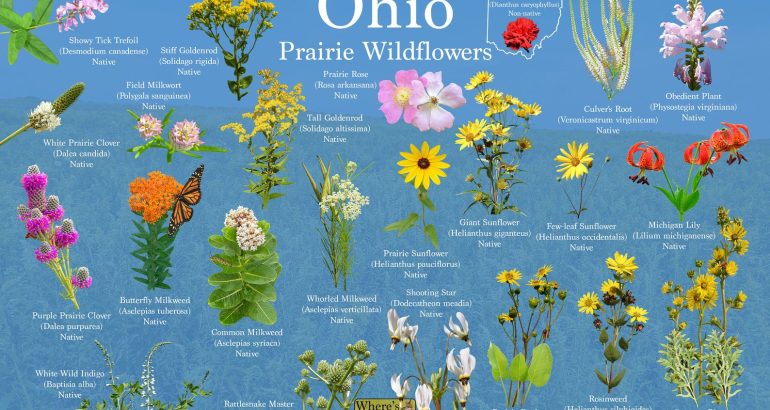If I walk around my neighborhood in the middle of Berea, one thing becomes clear- people love turf grass. Aside from buildings and driveways, most properties have 80 – 90% of lawn covered by turf grass that is surrounded by a narrow border of ornamental shrubs and flowering plants, typically plants that originate in Europe or Asia. Most folks keep their lawns mowed and flowers tended because they like the appearance of a well-kept yard. Also, well-tended lawns maintain property values. I suggest that this traditional approach to suburban landscaping should change to create landscapes dominated by native species.
Why Go Native?
Why should we focus on native plants? To answer this question, let’s first define what native plants are. They are the plants that existed in our area before human settlement occurred. Trees like the burr oak are native because they have been here for tens of thousands of years. The Norway maple, a favorite among our local nurserymen, is not native and has been here less than 300 years. It arrived with European settlers who used it for ornamental purposes. Why should we be concerned about the distinction between native and non-native plants?
To answer the latter question, let’s consider how plants interact with animals. Plants provide food for animals, everything from the leaves that caterpillars eat, to the seeds fed upon by squirrels, to the nectar extracted from flowers by bees. Of course, non-native plants also produce leaves, seeds, and nectar; but they do so in ways that are not helpful to our native animals who evolved with native plants. Animals recognize native plants as food resources, unlike non-native plants.
Often our non-native plants become pests because they have escaped the insects that typically eat them and limit their ability to spread. You should not worry that native plants will be destroyed by native plant-eating insects. Those insects are kept in check by many predators such as our native birds. So, our use of native plants helps to maintain long-established plant-animal interactions that prevent outbreaks of pests and provide food for organisms that generate valuable ecological services such as pollination and pest control.
Improve Your Lawn with Aesthetic Qualities of Native Plants
At this point, you might think that native plants do not provide the aesthetic qualities for our lawns and are difficult to find in nurseries. Fortunately, many professional landscapers are now working almost exclusively with native plants and are producing stunningly beautiful landscapes. To see examples, check out “Inviting Biodiversity into Our Garden.” This is a series of webinars sponsored by the Western Reserve Land Conservancy which you can watch on YouTube.
Finding native plants to use in your lawn is a lot easier than it used to be. Annual native plant sales at institutions such as the Nature Center at Shaker Lakes, the Holden Arboretum, and the Cleveland Museum of Natural History offer a wide variety of plants suitable for our region. There are also nurseries that specialize in native plants. Ohio Native Growers at https://ohionativegrowers.org offers a list of these nurseries.
The more you know about our native plants before buying, the better prepared you will be to ask important questions. Questions about geographic ranges, light and soil preferences, drought tolerance, etc. Try not to buy cultivars, i.e. plants that have been artificially selected to be showy; usually, native animals will not recognize them as sources of food. Uli Lorimer’s book, Northeast Native Plant Primer, provides good basic information on native plant biology to help you get started.
The most important thing to remember is that the use of native plants allows you to have a beautifully landscaped lawn that also serves as an important habitat for our native animals. As Dr. Doug Tallamy of the University of Delaware points out, you will become part of a homegrown national park (see: https://homegrownnationalpark.org. ). So, take the plunge and go native!!
Cover Photo from https://www.etsy.com/listing/1160322191/prairie-wildflowers-of-ohio-state-flower?gpla=1&gao=1
